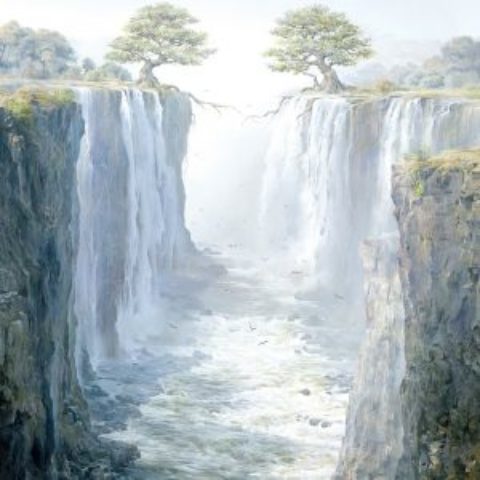“St. John of the Cross and the Image Breaking Forth from Darkness” (12/14/2019)
Fr. Ignatius John Schweitzer, OP
Elijah. John the Baptist. John of the Cross. These three men are kindred spirits. It’s no mistake that the Carmelite Order claims Elijah to be its founder and John of the Cross is eminent among its members.
We heard from the Book of Sirach, “Like a fire, there appeared the prophet Elijah whose words were as a flaming furnace…How awesome are you Elijah!…You were taken aloft in a whirlwind of fire, in a chariot with fiery horses.” St. John of the Cross too, in a way, was “taken aloft in a whirlwind of fire” and he shares with us that firey whirlwind in his reflections on prayer.
The life of prayer begins with the radical effort of an Elijah and the austere asceticism of a John the Baptist in the desert. Yet it ends with the fiery words taken by the Carmelites as their motto: “Zeal for thy house has consumed me.” The strenuous efforts of prayer gradually give way to being consumed by prayer. The efforts at ascending toward God gradually give way to being “taken aloft in a whirlwind of fire.” Activity yields to more and more receptivity and being taken up by the Lord.
Elijah’s arduous prayer to God brought fire down from heaven before the prophets of Baal (1 Ki 18:38). But later this activity yielded to receptivity. With his face wrapped in his mantle, Elijah finally receives the Lord in the still small voice (19:13). Elijah had made his offerings and called down fire but now he himself was the holocaust consumed by the Holy Spirit, consumed by the Spirit of prayer. And it took place in the still small voice.
In the Living Flame of Love, John of the Cross puts it simply when he says, “pure contemplation lies in receiving” (LF 3.36). And the soul “must journey to God in surrender” (LF 3.48). Receptivity and surrender.
He also gives a description of being consumed by the Fire of Love in contemplation. He says of the soul, “there seems to flow seas of loving fire within it…It seems to the soul that the entire universe is a sea of love in which it is engulfed, for conscious of the living point or center of love within itself, it is unable to catch sight of the boundaries of this love” (LF 2.10). Engulfed in the Sea of Love.
John of the Cross begins with the rigor and austerity of the desert, yet this culminates in surrender and receptivity, immersed in the Sea of Love, which has no boundaries, knows no bounds.
In all this, he has a message for us in this time of Advent. It’s interesting that this same man who so denied himself of created things comes back to write the most beautiful poetry using images drawn from created things. At times, images are rejected in a way, but images then come back in all their beauty in his poetry, now blazing with the glory of God in creation transfigured.
In our time of preparation for Christmas, there’s a similar movement. We enter the desert and clear the way for the coming of the Lord, to receive Him as He is. Not according to our too-limited ideas or notions but as He is in His full reality. Faith terminates in the res, the reality (Aquinas, ST II-II q. 1, a. 2, ad 2). We are challenged to once again get beyond our sometimes too-limited images of God to prepare the way for the true “Image of the invisible God, the firstborn of all creation…For in him all the fullness of God was pleased to dwell” (Col 1:15, 19). We prepare the way for Jesus, the Word made flesh, dwelling in the womb of the Blessed Virgin Mary and soon to be born in the stable of Bethlehem.
John of the Cross imagines God the Father saying of the Word, in whom He has said everything, “Fasten your eyes on him alone because in him I have spoken and revealed all, and in him you will discover even more than you ask for and desire…For he is my entire locution and response, vision and revelation, which I have already spoken, answered, manifested, and revealed to you by giving him to you as a brother, companion, master, ransom, and reward.” (Asc II.22.5).
Reflecting on Jesus, “the Image of the invisible God,” brought John into the depths of the mystery of God. He compares Christ to a mine of gold or a mine of various fine minerals. He says, “there is much to fathom in Christ, for he is like an abundant mine with many recesses of treasures, so that however deep individuals may go they never reach the end or bottom” (SC 37.4). This is why we can always turn again to the Word, turn anew to the Mysteries of Christ and enter new depths.
So in these last days of Advent, we enter again into the desert to prepare the way of the Lord, and to prepare ourselves for the true “Image of the invisible God.” So that from the depths of silence, the Word might break forth anew. From the receptive space of contemplative darkness, the Image might blaze forth anew. From the ashes left by Elijah’s fire, the phoenix might rise to new life. And from the stump of Jesse, a shoot might spring forth and blossom.
May the little Infant Jesus bring us, as He did John, to that infinite Sea of Love which engulfed him and consumed him. As John cried out one Christmas, gazing on Jesus in the manger, “Lord, if love is to slay me, the hour has now come!” (p 27) May we likewise be engulfed in the Father’s Love begotten.
